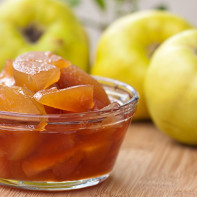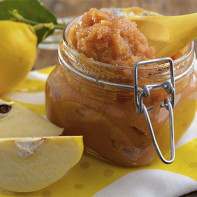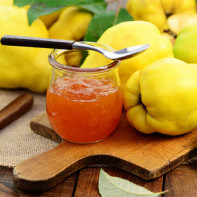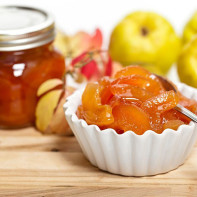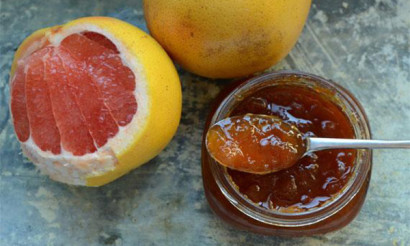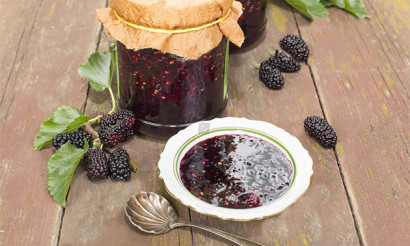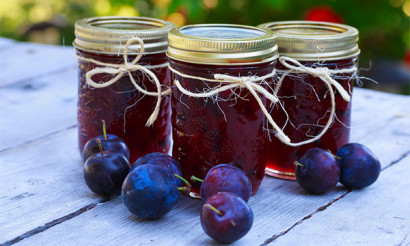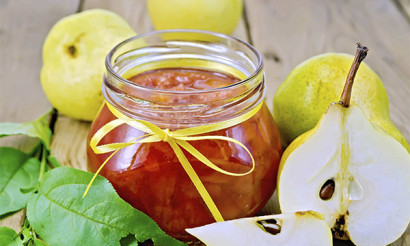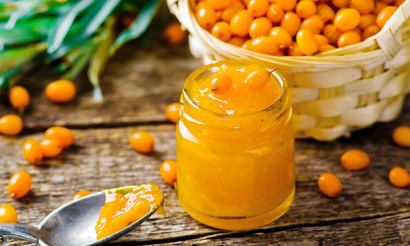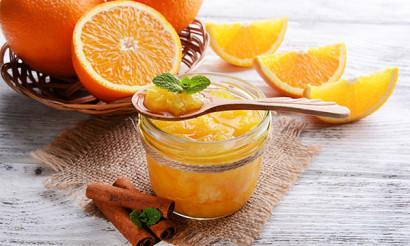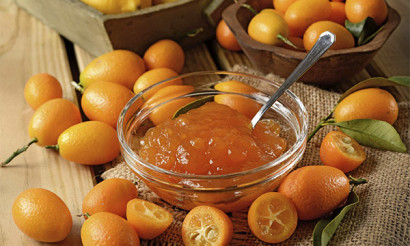Quince jam: 11 recipes
Quince has been known for over 4 thousand years. Its fruits are loved and appreciated in the Caucasus, Asia, and eastern countries. In the wild, it rarely bears fruit and tastes very tart and even slightly bitter. But cultivated varieties are appreciated in culinary and traditional medicine. The oldest quince is considered to be Portuguese quince, whose homeland was Ancient Rome. Fragrant, but quite hard pulp confuses inexperienced housewives. But experienced chefs know that it is best to make pastille, marmalade, compote from it, and there are about a dozen prescriptions for jam, and they all taste beyond praise.
- What does quince look like?
- Useful properties of the plant
- Fruit composition
- What is useful quince jam
- How to choose quince for jam
- How to cook quince jam: recipes
- Classic
- With walnuts
- With lemon
- With apples
- With orange
- With pumpkin
- With grape
- Cinnamon
- With ginger
- In a slow cooker
- In the microwave
- How to store jam
- Interesting facts about quince
What does quince look like?
From afar, its fruits can be confused with an apple, especially if they are on the counter side by side. But closer it becomes clear that these are completely different species. Quinces have round outlines, a shape slightly elongated to the peduncle. The color of ripe fruit is pale golden. The skin is covered with a delicate fluff, which is easily erased with a fingertip. The pulp is tough, slightly succulent, very aromatic. The taste is astringent, sweet. Ripe fruits can only be tasted in growing areas. After their sides have become soft, the fruits cannot be transported, since the fermentation process quickly begins in them.
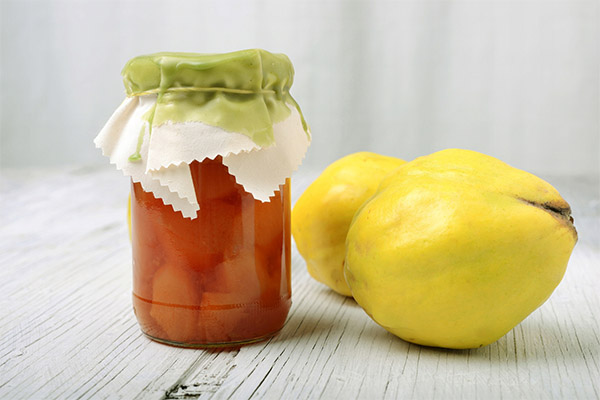
A tree on which such wonderful fruits are spewed is not tall, grows on almost any soil, is not afraid of frost, drought and high humidity. In natural conditions, it prefers the shores of water bodies; in the Caucasus it is found in deciduous forests next to oak, beech, dogwood, and dog rose. There are few fruits on wild animals, they are very small, about 15 g. But as a basis for stock, such trees are highly valued for their vitality and unpretentiousness to conditions. Most often, they are vaccinated with pears.
Quince is often found on sale. The season begins in September. Different varieties are found in shops and markets, they are usually brought from the Caucasus, Central Asia and the European part of Russia, including the Astrakhan region.
Useful properties of the plant
Valuable qualities are not only the fruits. Traditional medicine recipes use leaves and seeds. The green mass is collected and harvested in June-July. Seeds should be taken only from fully ripened fruits. The main effect of leaves and pulp:
- diuretic;
- restorative;
- antibacterial;
- antiviral;
- hemostatic;
- astringent.
Seeds are used as an enveloping agent, they are used for obstructive cough, chronic constipation, irritation of the gastric mucosa and esophagus.
If the leaves and shift during the harvesting process are dried, then the pulp is not stored in this form. It is processed according to various recipes, especially since with a short-term heat treatment, most of the useful substances are preserved.
Fruit composition
Those who have a risk of vitamin deficiency, anemia, low immunity, gastrointestinal tract diseases should pay close attention to quince. It contains:
- vitamins C, E, K, PP, group B;
- calcium;
- phosphorus;
- iron;
- magnesium;
- potassium;
- tannins;
- essential oil;
- fructose;
- gum;
- organic acids.
Interesting: the ratio of elements depends on the variety and place of growth of the plant.
Calorie content of 100 g of fresh pulp is low, within 40 kcal. But in this form they hardly eat it. Further caloric values depend on the method of preparation. The fruits are stewed, baked, boiled, used as an ingredient in sauces.
What is useful quince jam
It retains most of the original properties.The level of vitamins is reduced, as part breaks down during cooking, but the remaining amount is enough to provide immunity support, stabilization of the intestines, and the prevention of viral diseases. The astringent effect remains unchanged, so several teaspoons will be useful for diarrhea, but only after the acute period has passed.
Quince jam along with raspberry is used as an antipyretic, its diuretic effect is useful with high blood pressure and cystitis. Fiber acts as a natural abrasive, accelerating the cleansing of the body from toxins.
How to choose quince for jam
The taste of the finished product and its shelf life will depend on the quality of the fruit. With the beginning of the quince season a lot, the fruits differ in shape, size, taste, but the main signs of ripe fruit are the same:
- hard to the touch;
- the color is uniform, without green stripes and dark spots;
- the surface is covered with a soft fluffy layer;
- the aroma is strong, stable, without acidic shades;
- lack of mechanical damage to the skin.
It is worth considering: it is better to choose large fruits, they have a longer shelf life and taste better.
How to cook quince jam: recipes
In its finished form, it looks very beautiful - transparent, incorporating droplets of the sun and a little glowing with pinkish reflections, with even undigested slices of fruit. Quince goes well with nuts, a number of fruits, citrus fruits. It is cooked in different ways, only from one type of fruit or with the addition of additional ingredients.

Classic
It contains only sliced fruit and sugar in equal proportions. If the pulp is too dry, a small amount of water may be added during cooking. Despite the fact that quince is tough, it is boiled just like the rest of the fruit. Of the initial amount of products during cooking, only half will remain due to the evaporation of the liquid. So when buying a kilogram of fruit, you need to prepare a half-liter jar for spinning.
Washed fruit is cut into slices, a core with seeds is taken out. In order for the welding to turn out uniform, you need to cut quince with thin slices. Then they will be translucent in the syrup, tender, well-soaked in syrup and not boil. Jam is prepared in three ways.
- With exposure. Slices of fruit in layers layered with half the norm of sugar and leave for a day. Then add the rest, stir and boil over low heat until the pieces soften. In a boiling state, jam is poured into banks and covered with lids. You can use a tight seal.
- No exposure. First, boil the syrup from sugar and water in a proportion of 1 kg per 200 ml of liquid. Then, sliced slices are carefully laid out in a boiling mass and cooked with constant stirring until soft, after which they are laid out in jars. To preserve the jam well, the syrup must completely cover the fruit.
- Triple. Sugar-coated fruits stand for 24 hours, then the syrup is drained, brought to a boil and the fruits are poured. After 12 hours, the procedure is repeated. The whole mass is boiled for the third time until the pieces of fruit are soft, rolled up into jars.
The jam is pinkish, transparent, with a rich aroma and a slightly tart pleasant taste.
With walnuts
Honey nuts sold at fairs and beekeeping exhibitions are already used to. Quince with nuts looks no less elegant and festive. Gourmet jam cooked in accordance with all the rules will be a delicious present for a loved one. For cooking, you need 2 kg of fruit and the same amount of sugar, 200 g of walnut kernels, 400 ml of water, 1/4 teaspoon of vanilla or a bag of vanilla sugar.
This recipe uses fruits peeled and peeled. They are cut into slices and set aside under a lid or towel. The peel and core are put in a pan, pour 2 cups of water and boil for 10 minutes over low heat. The resulting liquid is used for further preparation of goodies. Fruit slices are laid in it and set aside from the stove for 6-10 hours to soak.
Then nuts and vanilla are added to the mass, boiled over minimal heat for 45 minutes. The finished treat is distributed among the banks. Store in a cool cellar or at room temperature.
With lemon
The tart taste of quince is perfectly shaded by lemon sourness. In addition, acid shortens cooking time by softening fruits much faster. For 1 kg of sugar you will need the same number of fruits and lemon juice. The bottom line is the short-term cooking of the mass, alternating with periods of infusion. The whole process will take 2 days, the time of active participation in it is 15 minutes.
Sliced quince slices are covered with sugar and left until juice is isolated. Usually enough 2-3 hours. Then add water, simmer for 5 minutes and remove from heat. The mass is defended for 12 hours. It takes 2 approaches. On the third add lemon, boil for another 5 minutes with constant stirring and packaged hot in storage containers.
Lemon can be cut into thin slices, pass through a blender or just squeeze the juice.
With apples
Very effective in appearance and delicious recipe without undue complexity. In some countries, quince is called a golden apple. It goes well to taste with winter varieties. They are just as solid and do not reveal taste immediately after collection from the branches, but they give up all the aroma in a two-component jam. The delicacy is prepared according to the classic recipe with aging for the initial production of juice.
With orange
The combination of citrus with quince gives a piquant taste and a charming golden color.
Interesting: in the fridge, the jam with the orange thickens.
2 kg of fruits need an equal amount of granulated sugar and 1 large ripe orange. First, the main ingredient is covered with sugar in the amount of 1/2 of the norm and incubated for 2-4 hours until juice, boil for 20 minutes. Then the liquid is drained, the remaining sugar is added and the mixture is brought to a boil, stirring until the crystals are completely dissolved. Pour the chopped quince with it and leave it to cool completely. Cubes of orange without zest are added to the fruit mass and jam is prepared for another 35 minutes. It is best to pour the delicacy into small jars. Open, it quickly loses some of the aroma.
With pumpkin
For 2 kg of fruit slices take 800 g of pumpkin and 2.5 kg of sugar. You can cook with aging and separate boiling juice, and a triple five-minute with standing for 12 hours. If you plan to store the finished product in a cool place, then the sugar rate can be reduced by 500 g.
First, quince is cooked, at the second boiling, gourds, cut into slices or cubes, are added. Slices of both ingredients boil better if they are approximately the same thickness. The jam is saturated, with a mild flavor, because the pumpkin absorbs and neutralizes the tart taste of a golden apple.
With grape
A large supply of fruit sugars is hidden in solar clusters. In ancient Rome, many delicacies were cooked on grape juice, and this quality can be used to advantage when preparing a mix with quince. The mass is cooked in one go, provided that the pieces of fruit are cut finely and finely. Grapes are used whole, removing only twigs. Weight calculation:
- quince - 680 g in peeled form;
- grapes - 450 g;
- sugar - 1 kg;
- water - 100 ml.
The mass is cooked in dishes with a thick bottom with constant stirring. The ingredients are put at the same time. First, the mixture is quickly heated, after boiling, the heat is reduced to a minimum and kept at a constant temperature for 1.5 hours. Abundant foam is formed from some grape varieties, which must be removed as they appear. As soon as the pan is removed from the stove, the hot mixture is distributed over the banks and sealed tightly. Store only in a cool room or on the bottom shelf of the refrigerator.
Cinnamon
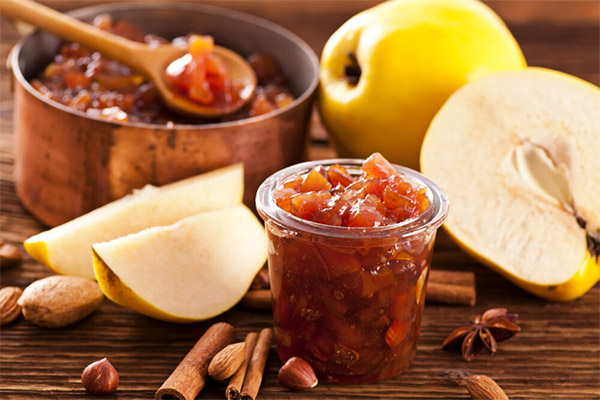
In the homeland of quince, spices are held in high esteem. In ancient times, they were very expensive, for 1 g in the market they gave ten times the weight of gold. Nowadays, you can buy any seasoning in a regular store. But for the preparation of quince jam it is better to visit the Indian incense shop and buy cinnamon in sticks. It will take 0.5 tsp of spice. You can grind it in a coffee grinder or put it whole.Textured cinnamon sticks will look interesting in a jar of jam. You do not need to take them out before pouring the finished product, cinnamon will give out taste and aroma during cooling.
Proportions:
- fruit slices - 1 kg;
- sugar - 700 g;
- water - 400 ml.
In some cases, it is allowed to add the juice of half a large lemon at the end of preparation to remove excess sweetness and increase the shelf life of the product.
With ginger
The benefit of this aromatic root is to give the dishes a piquant taste. Ginger is used as an anti-inflammatory, antibacterial agent. It enhances immunity, prevents vitamin deficiency, blocks the development of pathogenic bacteria. In combination with quince, jam acquires healing properties, helping to withstand during the period of epidemics of influenza and SARS.
As an ingredient in goodies, it is added at the rate of 50 g per 700 g of fruit and the same amount of granulated sugar. For cooking, take only fresh root. Half a glass of water is poured into the pan, sugar is added and mixed until boiling. Fruits and spices diced into thin syrup are dipped in syrup. They cook continuously on slow heating with constant stirring for 1 hour, after which the mass is laid out in sterilized jars and closed for the winter or until the first guests.
In a slow cooker
The advantages of this type of household appliances in a special bowl, which does not allow the dish to burn. It saves energy and time, as jam is being prepared, but you do not need to stand over it. Its taste is not inferior to jam, cooked the classic way in a pan.
For cooking, take an equal amount of sugar and fruits, 200 ml of water, 1/4 teaspoon of citric acid. The ingredients are laid at the same time, put the quenching mode for an hour. Some housewives recommend opening a slow cooker every quarter of an hour and stir the mass with a wooden spoon. But with the right ratio of ingredients, this is not required, especially if you apply a delayed start, giving the pieces of fruit to let the juice to increase the amount of liquid.
In the microwave
The cooking time of any dish in it is reduced several times. Another thing is that you still have to remove the container from the chamber so that the mass settles. It’s impossible to cook a treat at one time.
Slices of fruit are finely chopped so that they are quickly soaked in syrup. At the first stage, pieces of fruit are poured with water, sugar is added and set for 12 minutes at 80% power. Proportions:
- quince - 0.5 kg;
- sugar - 0.5 kg;
- water - 100 ml.
It is worth considering: the volume of a single serving of jam in the microwave will turn out to be small.
After the time on the timer is over, the container is removed on a wooden stand and left until the mass cools completely. It is advisable to cover it. It will take 3 approaches, during the latter you can add a little lemon juice or do only the basic ingredients.
How to store jam
Subject to the cooking technology, tightly corked jars are placed in a cool corridor, on an insulated loggia or left on a shelf in the pantry at room temperature.
The exception is a delicacy on grape juice or with whole berries. Its increased tendency to ferment when stored in heat can give rise to swelling of the lid. It is safer to eat a treat immediately after cooking or store in the refrigerator on a shelf for vegetables.
Interesting facts about quince
Like every plant, the golden apple has its own little secrets:
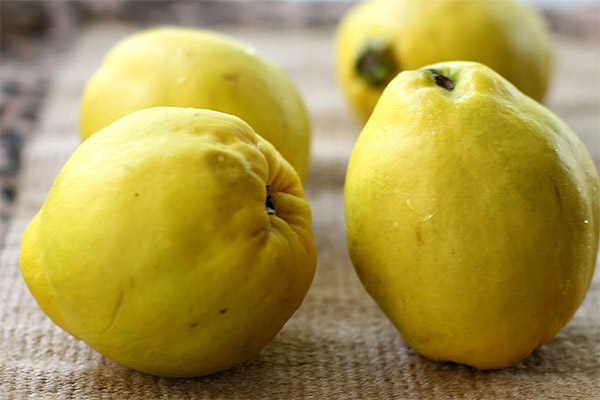
- Turkey is recognized as the leader in fruit growing volumes, the export share is 5 part of the total number by country.
- In the genus, only 1 species, no longer related to it.
- In the wild version, the tree bears fruit poorly, 3–7, maximum 10 small tart fruits ripen on the branches, weighing up to 100 g.
- The largest fruits of some varieties reach a weight of 2 kg.
- The plant was cultivated about 4 thousand.years ago, breeding work does not stop, new varieties regularly appear, adapted for more northern regions.
- In ancient times, the plant was dedicated to Venus and planted near its temples.
- The oldest variety is Portuguese quince.
- A number of trees are used as hedges, but require regular pruning and crown formation.
Quince jam has long been a popular treat in eastern countries. In middle latitudes, it grows in the Volga region, in the Caucasus and in the Krasnodar Territory. Buying aromatic fruits, it is worth giving preference to domestic species. They contain a little less sugar, but do not go to the shelves across half the globe, processed for the preservation of chemicals.
Fruits are inexpensive during the season, and in September it's time to devote 1-2 days to prepare an amazing treat, full of vitamins and good mood.
«Important: all information on the site is provided exclusively in fact-finding purposes. Before applying any recommendations, consult with a profile specialist. Neither the editors nor the authors are liable for any possible harm caused materials. "

